
| myArmoury.com is now completely member-supported. Please contribute to our efforts with a donation. Your donations will go towards updating our site, modernizing it, and keeping it viable long-term.
Last 10 Donors: Daniel Sullivan, Anonymous, Chad Arnow, Jonathan Dean, M. Oroszlany, Sam Arwas, Barry C. Hutchins, Dan Kary, Oskar Gessler, Dave Tonge (View All Donors) |
| Author |
Message |
David McElrea

|
 Posted: Sat 01 May, 2004 9:15 am Post subject: Posted: Sat 01 May, 2004 9:15 am Post subject: |
 |
|
Hi all,
Another question regarding Irish hilt-work. A cursory glance at surviving organic hilts seems to suggest somewhat poor craftsmanship (to my eyes anyway)-- see the first pic below as an illustration of this point. My questions may be unanswerable at this particular time, but...
The examples we have are few (which is to be expected as the hilts were frequently organic)-- is it likely that only the more "common" swords have been discovered? Is it possible that we are seeing swords who were hilted by their owners rather than by cutlers?
The anthropomorphic hilt is not unknown in Ireland, but I am not as interested in that style (these are thought to be imports, anyway, I think). Are there any other swords with non-organic fittings that I am missing here? If so, I would love to see some photos.
My reason for asking grows out of a deep appreciation for the skill found in nearly every other Irish artform as far back as the Bronze Age (or even Neolithic times-- see the Knowth mace head as an example). It seems strange that so little attention would be given to a high status weapon when it is evidenced everywhere else! I will also attach a picture of an Iron-Age bronze scabbard found in Ireland( which is representative of a number that have been found)-- it is strange to see them together with the hilts already mentioned.
Any thoughts would be appreciated.
David
 Attachment: 15.47 KB Attachment: 15.47 KB
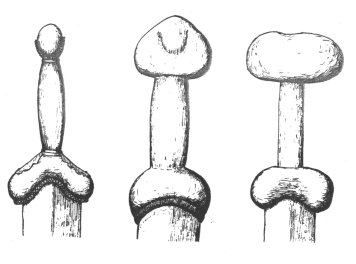
 Attachment: 16.75 KB Attachment: 16.75 KB

|
|
  |
 |
|
Nathan Bell
|
 Posted: Wed 05 May, 2004 8:22 pm Post subject: Posted: Wed 05 May, 2004 8:22 pm Post subject: |
 |
|
Hi David,
I wouldn't necessarily say that organic hilted blades show poor craftsmanship. The organic hilt, and somewhat plain ones at that, are pretty much "industry standard" at this time, and of course we see lots of quite "plain" forms. The early Iron age seems to not be uncommon to have predominantly organic hilts---so I don't think organic versus more substantial mettallic portions reflects a lack of skill?
BUT, taking this pic in order...
The first fromt he left is, IMO a rather poor reconstruction of the Lisnacrogher hilt. This is from Rynne's article...I also think he did it a bit off...I think the "U" shaped plate is meant to either cradle an inset spheroid---like the "pregnant egg" pommels, or it may set off a middle lobe in some form of trilobate pommel, or it may be something in between these types.
The middle picture is of the wooden Ballkilmurray sword, rendered even more crudley than the original appears. Since this is a wooden model, it may not be as flash in fit and finish as the real item it is meant to represent.
The third sword is one oft he grouo which Raftery calls "type B" hilts, the all---organic with no metal fittings at all. I have read at least 2 theories on these. One is that these are a good bit later, from 1st-3rd centuries AD and thus are somewhat "atrophied" from the original La Tene and Roman predecessors. Another explanation (I think Raftery may have suggested this---don't recall right now) is that these were indeed the "poor man's" copies of nicer hilted swords like the Lisnacrogher blades would have been.
As to the Lisnacrogher, and other swords with long-since decayed organic hilts, I firmly beleive the organic components would have been rendered with as much skill and aesthetic balance as the metal components. In the metallic components, you see subtle texturing and detailing of the surfaces even on the spacers and guard plates. Texturing and cross-hatching could well have been used to great effect across the organic surfaces. And this is not to discount the possibility of colorful staining, dying, painting and even burning of the organic components to acheive great visual appeal. Besides surface coloration, delicate incising in patterns could have been done. Further, the material themselves could have been carved in a variant of the "plastic" style, perhaps, in the "higher-end" swords like the Lisnacrogher blades. The organic materials themselves could have been slected for their visual effect as well---similar to how burl wood is often used on modern customs knives. "Tooth" and "white-hilted" is often used as a descriptor of hilts in the Irish sagas, so we could have seen the use of semi-precious material such as ivory, again possibly artisitcally stained engraved, incisised "scrim-shawed", etc.
I guess in summary I would have to say that one needn't look for hilts that are more predominantly mettallic to imagine very chieftainly hiltwork, and significantly pleasing artistic effect acheived via organic media.
| David McElrea wrote: | Hi all,
Another question regarding Irish hilt-work. A cursory glance at surviving organic hilts seems to suggest somewhat poor craftsmanship (to my eyes anyway)-- see the first pic below as an illustration of this point. My questions may be unanswerable at this particular time, but...
The examples we have are few (which is to be expected as the hilts were frequently organic)-- is it likely that only the more "common" swords have been discovered? Is it possible that we are seeing swords who were hilted by their owners rather than by cutlers?
The anthropomorphic hilt is not unknown in Ireland, but I am not as interested in that style (these are thought to be imports, anyway, I think). Are there any other swords with non-organic fittings that I am missing here? If so, I would love to see some photos.
My reason for asking grows out of a deep appreciation for the skill found in nearly every other Irish artform as far back as the Bronze Age (or even Neolithic times-- see the Knowth mace head as an example). It seems strange that so little attention would be given to a high status weapon when it is evidenced everywhere else! I will also attach a picture of an Iron-Age bronze scabbard found in Ireland( which is representative of a number that have been found)-- it is strange to see them together with the hilts already mentioned.
Any thoughts would be appreciated.
David |
|
|
   |
 |
|
Peter Johnsson
Industry Professional
|
 Posted: Thu 06 May, 2004 1:44 am Post subject: Posted: Thu 06 May, 2004 1:44 am Post subject: |
 |
|
Nathan,
Thanks for a good post.
I agree with you totally. It is easy to imagine wood, bone and horn being carved or scored with patterns and/or sculpted into very active three dimensional volumes of great beauty and elegance.
Seeing a Gladius hilt excavated from the site of the battel of the Teutoburger forest, it became quite clear that hilts of this general construction can be very phallic in the design.
It does not seem too far fetched that Celtic swords could follow this theme as well.
I´d also like to make a correction to an earlier post, regarding the placing of the pommel and guard of the Cotterdale sword. I did not mean that the pommel shouldbe turned the other way around, although my wording seems to imply that. Sorry for the confusion! The correct assembly is clear in the drawing posted by Kirk.
|
|
   |
 |
David McElrea

|
 Posted: Thu 06 May, 2004 4:32 am Post subject: Posted: Thu 06 May, 2004 4:32 am Post subject: |
 |
|
Hi Nathan,
Thanks very much for the post-- just thought I would clarify a couple of points where I mustn't have expressed myself very well. You wrote:
| Quote: | I wouldn't necessarily say that organic hilted blades show poor craftsmanship. The organic hilt, and somewhat plain ones at that, are pretty much "industry standard" at this time, and of course we see lots of quite "plain" forms. The early Iron age seems to not be uncommon to have predominantly organic hilts---so I don't think organic versus more substantial mettallic portions reflects a lack of skill?
|
My point wasn't that organic = "shoddy", but that the organic hilts that we see (as in the illustrations) seem to be quite crude. Again, this is not because they are organic, but because they look "primitive" and badly-made when compared to other finds (such as the scabbard finds, in particular). I suppose I found it strange that none of the finds seemed to be particulary "beautiful" or well-made in light of the artistic skills shown in other areas. Your commentary on the pics was very helpful in addressing some of those concerns.
You wrote:
| Quote: | | And this is not to discount the possibility of colorful staining, dying, painting and even burning of the organic components to acheive great visual appeal. Besides surface coloration, delicate incising in patterns could have been done. Further, the material themselves could have been carved in a variant of the "plastic" style, perhaps, in the "higher-end" swords like the Lisnacrogher blades. The organic materials themselves could have been slected for their visual effect as well---similar to how burl wood is often used on modern customs knives. "Tooth" and "white-hilted" is often used as a descriptor of hilts in the Irish sagas, so we could have seen the use of semi-precious material such as ivory, again possibly artisitcally stained engraved, incisised "scrim-shawed", etc. |
Again, fascinating... maybe some day something will turn up in one of the peat-bogs that will amaze us all. I hope so...
Are you aware of any non-organic (and non-anthropomorphic) hilt finds? I suppose I am hoping something a bit more hardy than the organic materials will have survived to give more ideas of the Irish look.
Thanks again for your response,
David
|
|
  |
 |
|
Nathan Bell
|
 Posted: Thu 06 May, 2004 5:45 am Post subject: Posted: Thu 06 May, 2004 5:45 am Post subject: |
 |
|
I think I see where the question was going re: Irish swords. It can be very, very frustrating trying to tease out the picture of the organic swords with so little evidence. At least on the continent, you have such large numbers of celtic, Roman, Iberian swords, etc. that you find a few with preserved hilts. With the North Scottish and Irish swords, it's pretty remarkable to have found as many organic components as we have---I think the total number of Irish Iron Age swords found to date still is under 50?
Also on the continent, we have funerary stelae and pottery and carvings which give us an inkling of rough form at times----even if it is often one culture trying to loosely depict a foreign one. In Ireland in the early Iron Age, nothing that I know of depicts the EIA sword in 2-D form (of course, it just might be my ignorance).
I'm not aware of any hollow cast or solid bronze (or stone, Iron, etc.) EIA hilts that appear to mimic the organic forms. Rafetry thought that the Ballykilmurray sword was perhaps a good rough guess. Although if this was either a model, or even a child's toy, I don't know how strictly it would adhere to the "real look" as I was saying earlier.
Kirk or John Spencer might know of more sources for the Irish material re: 2-D pictorial representations?
On the Cotterdale sword, I think it could be likely the pommel could have been turned either way. With the bronze capping the very butt of the pommel, we have a convergent look similar to the HOd Hill, and also similar to decoration found on some other Roman hilts---thinking here of the metallic decoration on the Republican era Delos gladius. The metal sort of fans out toward the grip, using the peen as the center point. But, the outlined shape of the bronze flipped the other way does look somewhat like other late Roman spathae, like the Koln...I could see it either way, really?
|
|
   |
 |
Kirk Lee Spencer

|
 Posted: Sat 08 May, 2004 8:47 pm Post subject: Metal Hilts Posted: Sat 08 May, 2004 8:47 pm Post subject: Metal Hilts |
 |
|
I can not think of any LaTene swords from Ireland or Britain with metal hilts other than the anthropoid stuff. Not too many such continental finds either... that I know of.
The most famous is the Kirkburn sword. (I don't like the sword that much but it has a nice name.)
I have also seen a Celto-Iberian sword that seems to have some kind of metal plates attached to the hilt.
And there is one other with circular spacers much like the one posted earlier on this thread.
ks
 Attachment: 74.3 KB Attachment: 74.3 KB
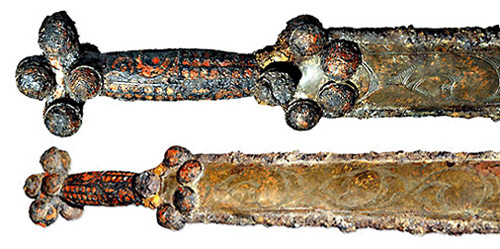
Kirkburn Sword found in Yorkshire. Pics from the British Museum
 Attachment: 74.03 KB Attachment: 74.03 KB
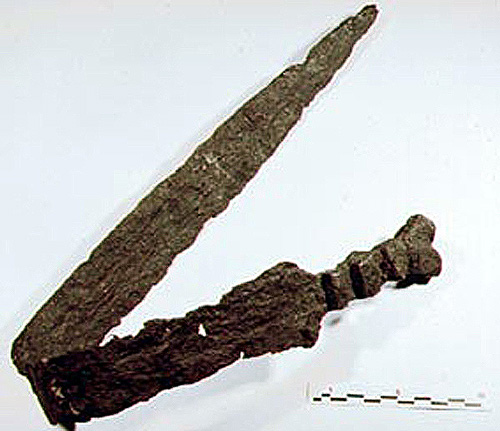
Celto-Iberian LaTene Sword
 Attachment: 90.9 KB Attachment: 90.9 KB
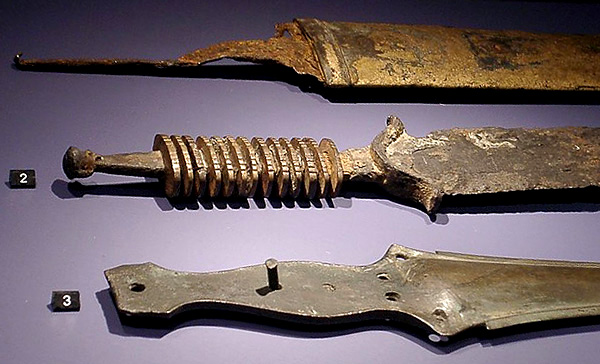
Composite Grip on LaTene Sword
Two swords
Lit in Eden’s flame
One of iron and one of ink
To place within a bloody hand
One of God or one of man
Our souls to one of
Two eternities
|
|
  |
 |
|
Nathan Bell
|
 Posted: Sat 08 May, 2004 10:01 pm Post subject: Re: Metal Hilts Posted: Sat 08 May, 2004 10:01 pm Post subject: Re: Metal Hilts |
 |
|
| Kirk Lee Spencer wrote: | I can not think of any LaTene swords from Ireland or Britain with metal hilts other than the anthropoid stuff. Not too many such continental finds either... that I know of.
The most famous is the Kirkburn sword. (I don't like the sword that much but it has a nice name.)
I have also seen a Celto-Iberian sword that seems to have some kind of metal plates attached to the hilt.
And there is one other with circular spacers much like the one posted earlier on this thread.
ks |
And as you'll notice, even these pieces originally had a good amount of organic material in the hilts. Even the Kirkburn originally had horn underneath the enameled grip piece and horn filling out the lobes of the pommel/guard areas. An issue of simply "more metallic components" rather than a metallic hilt.
I have seen (pictures) of a good number of Iberian swords with all metal and predominantly metal hilts, though. They also commonly have a form of doubled pommel, too, often two very spherical knobs.
I kind of like the Kirkburn, though, Kirk! The enamel work is a bit over the top, but I think the hilt shape is pretty nice, actually?
|
|
   |
 |
Kirk Lee Spencer

|
 Posted: Sun 09 May, 2004 6:29 am Post subject: More Metallic Hilts Posted: Sun 09 May, 2004 6:29 am Post subject: More Metallic Hilts |
 |
|
Hi Nathan...
You're right. These hilts were not all-metallic. I thought the Kirkburn (Yorkshire England--not a continental find as I said in earlier post) was all metal and glass... thanks for the info on the horn surrounding elements... I wonder what the pommel and guard profiles would have looked like. Who knows, with these elements I might like the looks--It would balance out the hilt a little more I think.
Here is a link ( http://www.ffil.uam.es/equus/warmas/tipolog/fig01.html ) to a slide show from a museum in Spain. I have taken you into the slide show at my favorite Horse-Head Falcata... The rest of the show is well worth seeing.
Are these swords similar to the Iberian LaTene swords you mentioned Nathan?
They seem to be hybrids between the older anntena sword/daggers and the later earliest Celtic stuff?
ks
 Attachment: 27.77 KB Attachment: 27.77 KB
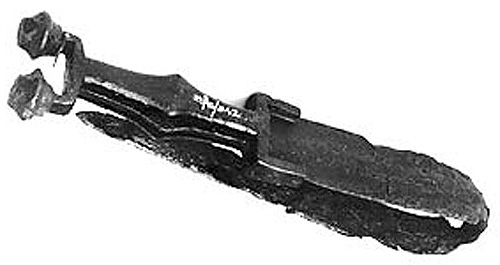
Celto-Iberian Anntena-like sword
 Attachment: 30.37 KB Attachment: 30.37 KB

Anntena-like Celto-Iberian Sword
 Attachment: 15.09 KB Attachment: 15.09 KB

Another Anntena-like Celto-Iberian
Two swords
Lit in Eden’s flame
One of iron and one of ink
To place within a bloody hand
One of God or one of man
Our souls to one of
Two eternities
|
|
  |
 |
|
Nathan Bell
|
 Posted: Sun 09 May, 2004 9:03 am Post subject: Re: More Metallic Hilts Posted: Sun 09 May, 2004 9:03 am Post subject: Re: More Metallic Hilts |
 |
|
| Kirk Lee Spencer wrote: | Hi Nathan...
You're right. These hilts were not all-metallic. I thought the Kirkburn (Yorkshire England--not a continental find as I said in earlier post) was all metal and glass... thanks for the info on the horn surrounding elements... I wonder what the pommel and guard profiles would have looked like. Who knows, with these elements I might like the looks--It would balance out the hilt a little more I think.
Here is a link ( http://www.ffil.uam.es/equus/warmas/tipolog/fig01.html ) to a slide show from a museum in Spain. I have taken you into the slide show at my favorite Horse-Head Falcata... The rest of the show is well worth seeing.
Are these swords similar to the Iberian LaTene swords you mentioned Nathan?
They seem to be hybrids between the older anntena sword/daggers and the later earliest Celtic stuff?
ks |
Yes, those are the types of swords I was rather inadequately describing!
It does indeed seem to me like the Iberians took the earlier Halstatt antennae dagger/short swords and went a different direction with them. Some that look very much like those you have posted, I have seen labeled with dates that would correspond with celtic eras as late as mid La Tene II. I suppose the Iberians enjoyed staying closer to the "old school" artistic styles?
I really like those little Iberian swords, too. Perhaps a nice custom project for down the road, or something for the Albion NextGen list 
|
|
   |
 |
Kirk Lee Spencer

|
 Posted: Mon 10 May, 2004 6:24 am Post subject: Posted: Mon 10 May, 2004 6:24 am Post subject: |
 |
|
Nathan...
Actually it was a great description... I had just not thought to check dates on those types of swords or considered that they were as close to the ball-like LaTene hilts as they were to the antenna types.
By the way, do you know if the enamel we see on celtic sword, shields etc, was similar to modern enamel paint... Have you read how they made and applied this material.
Thanks
ks
Two swords
Lit in Eden’s flame
One of iron and one of ink
To place within a bloody hand
One of God or one of man
Our souls to one of
Two eternities
|
|
  |
 |
|
Nathan Bell
|
 Posted: Tue 11 May, 2004 4:08 am Post subject: Celtic enamel Posted: Tue 11 May, 2004 4:08 am Post subject: Celtic enamel |
 |
|
| Kirk Lee Spencer wrote: | Nathan...
Actually it was a great description... I had just not thought to check dates on those types of swords or considered that they were as close to the ball-like LaTene hilts as they were to the antenna types.
By the way, do you know if the enamel we see on celtic sword, shields etc, was similar to modern enamel paint... Have you read how they made and applied this material.
Thanks
ks |
Hi Kirk,
I have read a brief article by Gunther Haseloff on celtic enamel. He says
| Quote: | The enamel used by the celts consists of quartz glass with a small quantity of added lead. The glassy mixture was turned red by adding cuprite, Cu 2 O. During the normal heating process, Cuprite is transformed to cupric oxide, CuO, murky green in colour; the cuprote therefore had to be processed further and the oxygen removed.It seems that in most cases the glass mass was heated jsut until it became soft and then pressed into the cavities of the metalwork after roughening the surfaces to ensure adhesion. The enamel workshops discovered at Bibracte (Mont-Beuvray) yielded a great many objects the enamel of which had clearly come away from the setting
Two techniques were used in eneamling. In the first, the enamel was poured in semiliquid form into the settings (email champleve) In the second the enamel was secured to the surface of the metal with rivets. |
The author also states that coral insets and enamel were used side by side: the Witham shield had coral insets, while the Battersea shield was enamel...
He also mentions the yellow enamel, stating that it is mostly found in Scotland. He doesn't say what chemical was added to the quartz to make yellow 
|
|
   |
 |
Kirk Lee Spencer

|
 Posted: Tue 11 May, 2004 6:21 am Post subject: Posted: Tue 11 May, 2004 6:21 am Post subject: |
 |
|
Thanks so much Nathan. That is exactly what I was looking for!
You are a great resource... I,m glad you're here.
ks
Two swords
Lit in Eden’s flame
One of iron and one of ink
To place within a bloody hand
One of God or one of man
Our souls to one of
Two eternities
|
|
  |
 |
Kirk Lee Spencer

|
 Posted: Sat 15 May, 2004 10:07 pm Post subject: Irish LaTene Posted: Sat 15 May, 2004 10:07 pm Post subject: Irish LaTene |
 |
|
| David McElrea wrote: | Hi Nathan,
I just wanted to thank you for your great responses. I'll keep an eye out for the articles-- couldn't find them anywhere online (to buy). I suppose I may just not know where to look. Anyway, thanks again.
Yours,
David |
David...
I thought I would post my favorite Rynne article:
"Some Early Iron Age Sword Hilts from Ireland and Scotland"
Even if you have seen it, I think it would go well with this thread.
ks
 Attachment: 99.46 KB Attachment: 99.46 KB

"Iron Age Sword Hilts of Ireland and Scotland" by Etienne Rynne
 Attachment: 65.27 KB Attachment: 65.27 KB
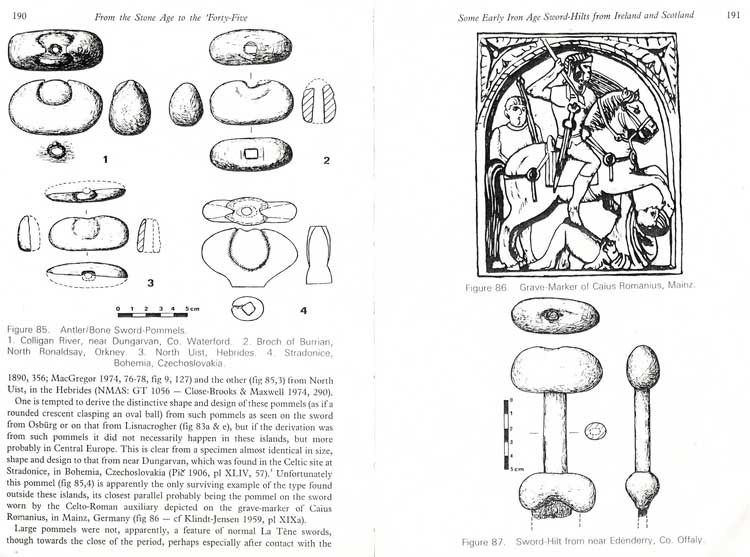
"Iron Age Sword Hilts of Ireland and Scotland" by Etienne Rynne
 Attachment: 74.71 KB Attachment: 74.71 KB
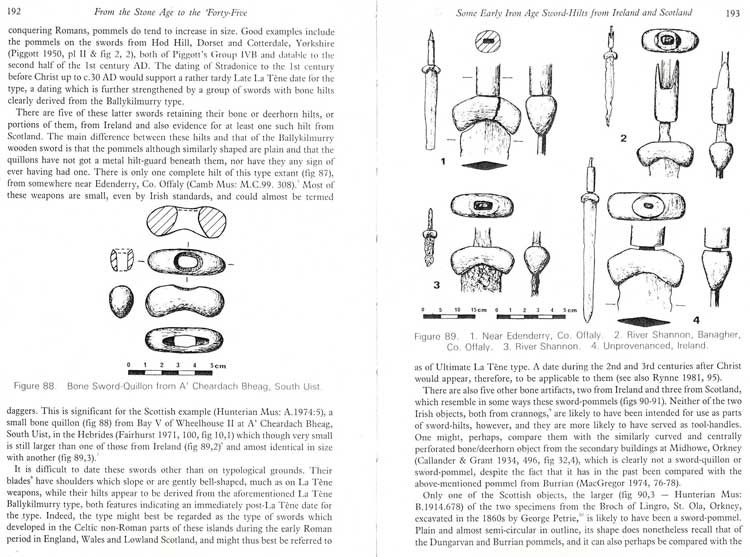
"Iron Age Sword Hilts of Ireland and Scotland" by Etienne Rynne
Two swords
Lit in Eden’s flame
One of iron and one of ink
To place within a bloody hand
One of God or one of man
Our souls to one of
Two eternities
|
|
  |
 |
Kirk Lee Spencer

|
 Posted: Sat 15 May, 2004 10:13 pm Post subject: Posted: Sat 15 May, 2004 10:13 pm Post subject: |
 |
|
Here is the last page...
ks
 Attachment: 70.93 KB Attachment: 70.93 KB
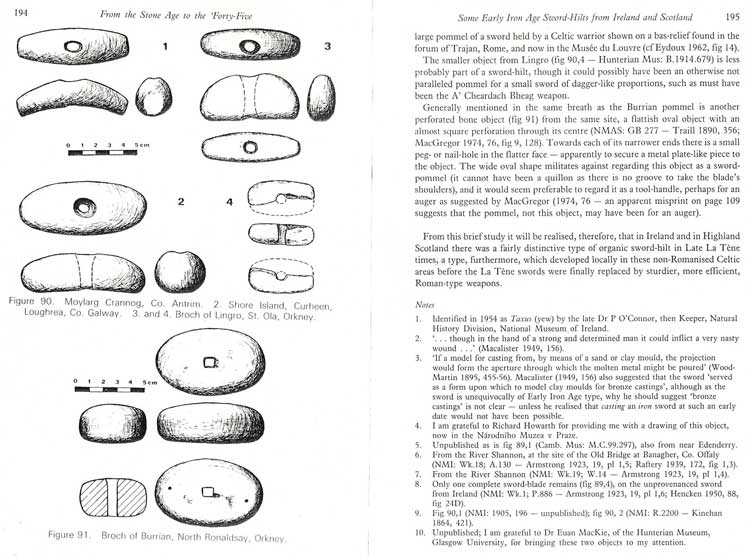
"Iron Age Sword Hilts of Ireland and Scotland" by Etienne Rynne
Two swords
Lit in Eden’s flame
One of iron and one of ink
To place within a bloody hand
One of God or one of man
Our souls to one of
Two eternities
|
|
  |
 |
David McElrea

|
 Posted: Wed 19 May, 2004 12:47 pm Post subject: Posted: Wed 19 May, 2004 12:47 pm Post subject: |
 |
|
Hi Kirk,
Thanks very much for posting Rynne's article-- In fact I hadn't yet seen it. Sorry for the delayed response, as well. I'm in Norway (on my brother-in-laws computer) and haven't been online for a few days (two hundred and something posts since Iast signed in to myArmoury!).
Either way, fantastically helpful. Thanks again,
David
|
|
  |
 |
John Gage
Industry Professional

Location: New Glarus, WI Joined: 01 Mar 2004
Posts: 154
|
 Posted: Wed 26 May, 2004 6:32 pm Post subject: Custom damascus celtic leaf blade dagger Posted: Wed 26 May, 2004 6:32 pm Post subject: Custom damascus celtic leaf blade dagger |
 |
|
Great thread guys. I was so inspired by it i got to working on a custom celtic leaf blade. I had ordered some pattern weld billets and thought i would use one for this project. I have just finished forging the blade and an initial grind. I am still pondering the exact hilt and pommel design. The hilt will be of wood and bronze. I am considering mahogany, maple burl, walnut burl , Padouk or zebrawood. I am also cosidering fullers. Here are some pics of where im at. The billet, blade and possible hilt design.
11" Blade
17" overall
|
|
   |
 |
Kirk Lee Spencer

|
 Posted: Sun 06 Jun, 2004 6:01 pm Post subject: Posted: Sun 06 Jun, 2004 6:01 pm Post subject: |
 |
|
Hi John...
I have been out of my office for awhile so I did not see that there had been a response to this thread...
Looks like you have a great start there. I think I would use the mahogany. For some reason exotic or fancy burl woods just don't look right to me on these ancient swords (maybe I have seen too many art knives at the shows). Also a more simple wood in the hilt would not distract from the beautiful shape of the blade and the damascus patterns...
Be sure and post a picture when you are done.
Many of the early iron age swords had an anthropomophic hilt. I think that it looks good on smaller swords.
Most of these hilts are of solid bronze... like the urnfield bronze hilt you posted), yet the the upper and lower parts of the hilt are stretched out to look like arms and legs.
I think that many of the earliest iron swords with organic components to the hilt also had a more anthropomorphic look.
I found an archeological report where the researchers excavated around the carbonized remains of the hilt and then took a plaster cast of it. This gives a rare glimpse into what the geometry of one of these organic hilts may have looked like.
The image in the far right is all that would normally be found of such a hilt. The next picture to the right is the two pasts of the plaster casting. finally to the far right is a replica made from the shadowy information gained from the carbonized remains.
ks
 Attachment: 79.93 KB Attachment: 79.93 KB
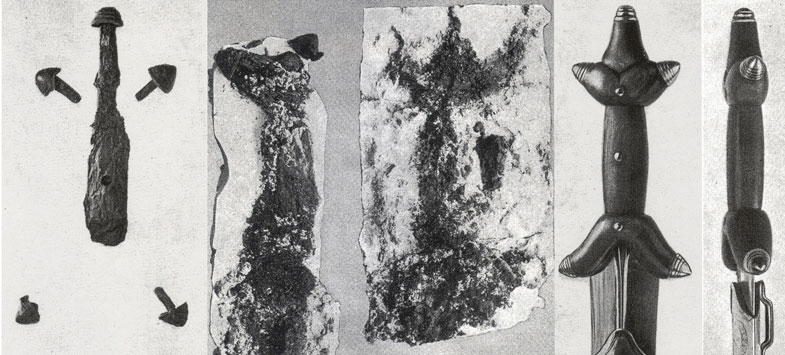
Carbonized LaTene Hilt with Reconstruction
Two swords
Lit in Eden’s flame
One of iron and one of ink
To place within a bloody hand
One of God or one of man
Our souls to one of
Two eternities
|
|
  |
 |
|
Nathan Bell
|
 Posted: Wed 09 Jun, 2004 4:27 am Post subject: Posted: Wed 09 Jun, 2004 4:27 am Post subject: |
 |
|
| Kirk Lee Spencer wrote: | Hi John...
I think that many of the earliest iron swords with organic components to the hilt also had a more anthropomorphic look.
ks |
I would agree. I didn't use to care for the Liebau sword, but it's really grown on me. Interesting how it combines forms to look both phallic and anthropomorphic at the same time!
I believe a good many of the organic La Tene I and II swords are aiming to achieve a stylized anthropomorphic look, from what fittings are sometimes left....seems you can also see the development of these trilobate "anthro" pommels into the later period (and often Romanized) styles like the "pregnant egg" styles seen in Ireland and North Scotland.
Thanks for the photos and such, it really helps illustrate this discussion (I don't have a scanner, myself  ) )
|
|
   |
 |
John Gage
Industry Professional

Location: New Glarus, WI Joined: 01 Mar 2004
Posts: 154
|
 Posted: Wed 09 Jun, 2004 5:09 pm Post subject: Posted: Wed 09 Jun, 2004 5:09 pm Post subject: |
 |
|
Hi Kirk,
I agree mahogany for the hilt would be the best choice. I like the hilt you have posted i just might use something like that design. I will post a few pics when im finished and would like to get your thoughts on it. Ive just setup my lathe and should have a gas forge built very shortly. Woohoo! I am so done with coal. This forum is an excellent place for a new artisan to get ideas and thoughts from very knowlegeable people.
Regards,
John
.
|
|
   |
 |
Kirk Lee Spencer

|
 Posted: Mon 14 Jun, 2004 8:24 pm Post subject: From Proto-Celtic to Romano-Celtic Posted: Mon 14 Jun, 2004 8:24 pm Post subject: From Proto-Celtic to Romano-Celtic |
 |
|
| Nathan Bell wrote: | | Kirk Lee Spencer wrote: | Hi John...
I think that many of the earliest iron swords with organic components to the hilt also had a more anthropomorphic look.
ks |
I would agree. I didn't use to care for the Liebau sword, but it's really grown on me. Interesting how it combines forms to look both phallic and anthropomorphic at the same time!
I believe a good many of the organic La Tene I and II swords are aiming to achieve a stylized anthropomorphic look, from what fittings are sometimes left....seems you can also see the development of these trilobate "anthro" pommels into the later period (and often Romanized) styles like the "pregnant egg" styles seen in Ireland and North Scotland.
|
Hi Nathan…
Great insight there... I also enjoy speculating on how these swords have developed through time.
As a matter of fact it is tracing this type of organic growth in sword design that has intrigued me for the last year or so… sort of a research project of mine… to trace the development of the sword through what I call “design space.” Since we very rarely have perfect knowledge of a swords exact date or geographic distribution, I would like to put aside strict chronological considerations and all geographic restrictions (for this project at least) and just take the swords as we find them in museums, private collections and archeological reports.
From this collection of swords, I want to select a series of individual swords that would reflect a somewhat hypothetical organic type of growth or evolution from early Bronze Age daggers to the hangers of the 19th century.
The end product would be to overlay each of these swords in order and create a video of sorts showing one possible trajectory of the growth of the sword in “design space.”
Just as a historian may recognize a beautiful archetypical sword that captures the ideal characteristics of a period sword, this would be a sort of archetypical progression of swords.
I have divided the task into five divisions:
1. Bronze Age
2. Celtic Swords
3. Migration/Viking Swords
4. Knightly Swords
5. Complex Hilts
For this post, I have quickly put together my current series for Celtic Swords…
To get the full effect you should move your eyes from sword to sword, like you were reading words, from left to right, top to bottom. “Read” through once concentrating on the pommel. Then do it again concentrating on the grip. And one more time focusing on the lower guard. I hope that you will be able to see what I am talking about… seeing a sword “grow” in design space.
ks
 Attachment: 89.45 KB Attachment: 89.45 KB
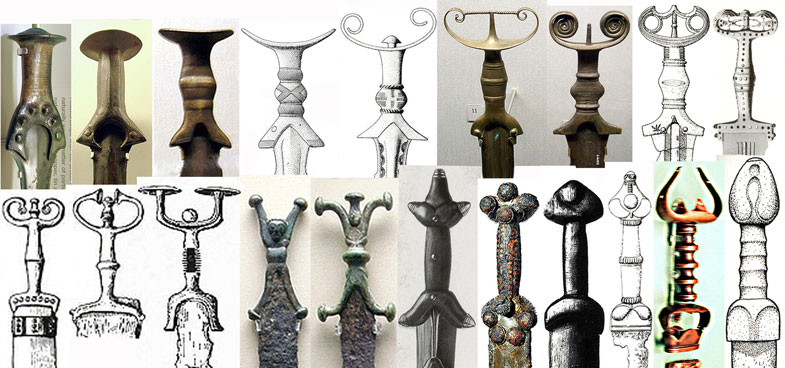
Celtic Sword Growth from Bronze Age (upper row) through Iron Age (lower row)
Two swords
Lit in Eden’s flame
One of iron and one of ink
To place within a bloody hand
One of God or one of man
Our souls to one of
Two eternities
|
|
  |
 |
|
|
You cannot post new topics in this forum
You cannot reply to topics in this forum
You cannot edit your posts in this forum
You cannot delete your posts in this forum
You cannot vote in polls in this forum
You cannot attach files in this forum
You can download files in this forum
|
All contents © Copyright 2003-2024 myArmoury.com — All rights reserved
Discussion forums powered by phpBB © The phpBB Group
Switch to the Basic Low-bandwidth Version of the forum
|

